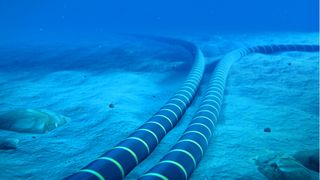Google is building two more whopping submarine internet cables
Google adds to its extensive portfolio of submarine web cables

Google has announced it is building a further two undersea internet cable systems to boost network capacity between the Middle East, southern Europe and Asia.
The two systems - named Blue and Raman - will be constructed in partnership with communications company Sparkle and equipped with a whopping 16 fiber pairs, each capable of carrying millions of high-definition videos simultaneously.
Once complete, the former will connect Italy, France, Greece and Israel, while Raman (named after a Nobel prize-winning physicist C.V. Raman) will dock in Jordan, Saudi Arabia, Djibouti, Oman and India.
- Here's our list of the best web hosting services right now
- Check out our list of the best shared hosting services available
- We've built a list of the best dedicated hosting services out there
Google undersea web cable
The Blue and Raman systems extend Google’s already healthy portfolio of undersea web cables, which run between every continent on earth, with the exception of Antarctica.
Most recently, the company unveiled the Firmina cable, which joins the US with Argentina, via Brazil and Uruguay. The cable is not only among the highest capacity subsea cables in the world, but it’s also the longest capable of running from a single power source, which creates redundancy in the event of a blackout at one end.
Including the two new systems, Google now owns at least a portion of eighteen different subsea cables, many of which are co-owned with fellow tech giants Amazon, Microsoft and Facebook.
Commenting on the Blue and Raman cable systems, Google said: “Developing additional network capacity and routes is critical to Google users and customers around the globe, who depend on robust connectivity to power their online lives, and communicate with friends, family and business partners.”
Are you a pro? Subscribe to our newsletter
Sign up to the TechRadar Pro newsletter to get all the top news, opinion, features and guidance your business needs to succeed!
According to the internet giant, regular Google users and Google Cloud customers will both benefit from an increase in capacity and decrease in latency in the regions connected by the new cables.
At the moment, Google says it expects to be able to bring both systems online in 2024, although harsh deep sea conditions mean delays are common in the sector. Eventually, the company hopes to dock the cables in additional locations and connect up the two disparate systems via terrestrial links.
- Here's our list of the best cloud computing services out there

Joel Khalili is the News and Features Editor at TechRadar Pro, covering cybersecurity, data privacy, cloud, AI, blockchain, internet infrastructure, 5G, data storage and computing. He's responsible for curating our news content, as well as commissioning and producing features on the technologies that are transforming the way the world does business.
